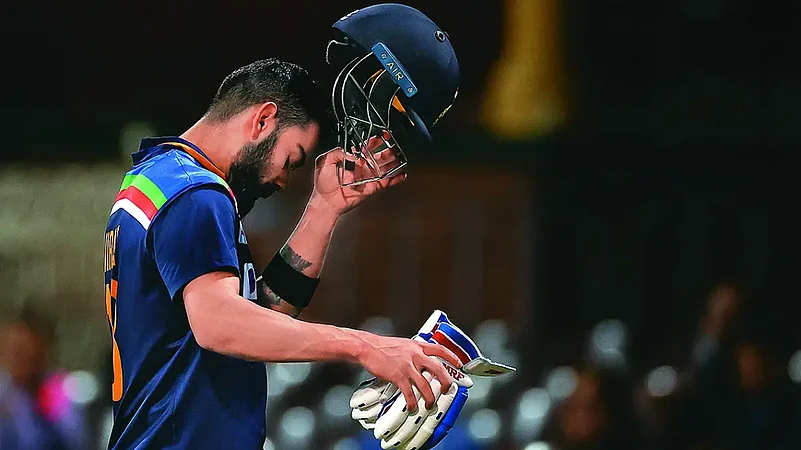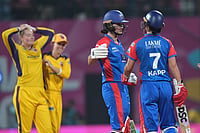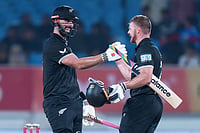When Virat Kohli last hit an international century, Covid was yet to happen. Yes, it’s been that long.
Pickings from limited overs cricket have not been as meagre as in Tests for the 33-year-old superstar in the period beginning late 2019 to the present. But even in the shorter formats, Kohli’s report card is not the succession of straight As it once used to be. His peaks are occasional, and the lows are often glaring, single-digit crumbs.
Kohli’s last ten T20 International innings are 77 not out, 1, 80 not out, 57, 9, 2 not out, 17, 52, 1 and 11. He also had an average IPL last season, making 341 runs in 16 matches for Royal Challengers Bangalore, at an average of 22.73 and a strike rate of 115.98. He scored two fifties. Thrice in the IPL, he scored golden ducks. Three first-ball departures would be an embarrassment for any late-order batsman, let alone someone like Kohli.
These are not the scores of Virat Kohli, The Original. These are scores of Virat Kohli, The Shadow, wearied by a host of factors ranging from poor form, tension with BCCI and, reportedly, a dressing room he himself alienated with his high-handedness.
Kohli insists there is no one particular reason for his dip in form. “What happened in England (his previous bad patch in 2014) was a pattern, so [it was] something that I could work on, something I had to overcome. Right now, there is nothing that you can point out saying look, here is a problem,” Kohli said in a media interview in May. “At times, when I start feeling that rhythm back, I know I am batting well, which wasn’t the case in England, [where] I didn’t feel like I was batting well at all.”
Rajkumar Sharma, Kohli’s childhood coach, is in regular touch with his ward. He tells Outlook that Kohli was not doing anything wrong technically, even though he agreed that the off-stump line—which Sunil Gavaskar has spoken about at length in the context of Kohli’s dismissals—remains a challenge. However, Sharma says Kohli has shown he can master that corridor of uncertainty.
“It is the most daunting line for any batsman, let alone Virat,” Sharma says. “It puts a batsman in two minds—whether to play a ball or to leave it. It is a line where there often are three slips, a gully and a keeper waiting to latch on to the faintest of snicks. With helpful conditions for swing and seam bowling, that line becomes difficult for anybody. Virat has shown the ability to negotiate it well. During the 2014 series in England, he struggled, especially against Jimmy Anderson (he averaged just over 13 in 10 Test innings in that series), but later that year in Australia, he got four centuries (692 runs at an average of 86.50). He also did well when he played again in England in 2018 (593 runs in five Tests). He knows his ability and he’s got tremendous self-belief.”
The mention of ability and self-belief—two oft-mentioned essentials for form—lead us to the question: what is form? What are its manifestations? How does being in form feel? What factors help an athlete regain form?
Practice is one pathway. Hours of practice. Boring, but reliable.
“The only way I could get into that zone (of high performance) was by preparation,” Brian Lara said at the 2017 Cowdrey Lecture. “I was a batsman who was very vulnerable at the beginning of my innings. I’d give the bowlers 70 per cent chance to get me out, and only had a 30 per cent chance of survival. A couple of hours later, it would be 50-50. A further couple of hours later, it would be 90-10.”
When you are one with your work and you do it at a high standard and intensity, hour after hour, that could possibly be called form. It is a God that all athletes pray to. And one which, like other mythical entities with the same calling card, has various avatars, one of which is confidence.
ALSO READ: Form Is A Mental Thing: Gautam Gambhir
“Cricket is all about confidence, and confidence is built only when you are performing consistently at the highest level,” Dilip Vengsarkar, ex-India captain, tells Outlook. “As a batsman, being in form means you can convert good deliveries into runs and put away loose deliveries for the maximum [runs]. Your body language, your attitude too, play important roles. Your hand-eye-body coordination works splendidly.”
Another avatar of form is timing. The ball is hit so well that the shot makes a resonant sound and goes where it is intended to. The late Vasoo Paranjape, one of the most knowledgeable and interesting characters in Indian cricket history, once told Gavaskar, “If you are at Churchgate Station and hear a sweet sound of bat hitting ball, it means Hanif Mohammad (the original Little Master, from Pakistan), is batting at the [nearby] Wankhede Stadium.”
Few athletes have been as obvious embodiments of form as Roger Federer. In terms of statistics, Federer has been eclipsed by Rafael Nadal and Novak Djokovic. But when you speak of a sportsman in full flow, it is the image of Federer majestically floating around the court that comes to many minds.
To Federer, being on top of his game felt as if he was operating in slow motion. “Everything for me happens in slow motion, while for my opponent, they happen in real time. You almost feel like you have more time, you are more serene and relaxed,” he said.
Also, an appreciative and egging crowd often inspires an athlete to raise his performance level and find form, Federer suggested. “You know it’s time to be in the zone when the crowd gets into it,” he said.
Form is also about toil. VVS Laxman showed grit and grace when he scored the greatest Test innings in Indian cricket history, a ten-and-a-half-hour-long 281 against Australia in the humidity of Kolkata’s Eden Gardens in 2001. Rahul Dravid was his ally with 180. The two put on 376 runs, as India followed on and yet scored an improbable win.
“I was battling back spasms and Rahul was cramping really bad,” Laxman said during a recollection of the epic. “We motivated each other—one ball, one over, one hour. As it turned out, we batted the whole day. At the end of the day’s play, both of us were on drips.”
Another sign he was in form, Laxman said, was that he was picking the length of the ball early. It allowed him a fraction of a second more to play his shots.
But form is also known to desert an athlete. Sometimes, there are clear reasons why. Sometimes, there aren’t. One of the best encapsulations of form’s strange ways came in the 1980s, from one-time tennis prodigy Jimmy Arias. “When you are on a roll, you stay on it, until something happens,” Arias later said. He started out as a whiz, winning several matches, reaching the top-5, making lots of money, until “something happened”. Ultimately, his performances did not match his early promise.

Loss of form pushes athletes into confidence crises, frustration or depression. Steeplechaser Avinash Sable, India’s Commonwealth Games hero, alluded to it when discussing his shocking 11th place finish at the World Athletics Championships, just days before the CWG.
“Only I know how I spent the last 15-20 days. I became depressed and stopped talking to people, I replied to nobody,” Sable said about the dark phase. A mix of going back to basics, rest, technical adjustments and luck is the only way to fight out of the rut.
Says Vengsarkar, “Batsmanship is all about how you analyse a situation, wicket and conditions you are playing in. In England, I made it a point to stay side-on all the time, and not open up my left shoulder. On bouncier wickets, it’s always advisable to play square of the wicket. A batsman can avoid playing certain shots when he goes to the crease, before assessing the above-mentioned aspects.”
Two major events, the Asia Cup and the T20 World Cup, are coming up for Kohli to rediscover his once imperious form. The last few days, he has been in training at the Mumbai Cricket Association’s Bandra Kurla Complex (BKC) premises.
“My main aim is to help India win the Asia Cup and the World Cup, and for that I am ready to do anything for the team,” Kohli said in a recent statement.
***

“If the world’s No. 2 bowler (Ravichandran) Ashwin can be dropped from the Test side then the (once) world No. 1 batter can also be dropped. Virat is not batting at a level which we have seen him at over the years. He has made a name because of his performances but if he isn't performing, then you can't keep the performing youngsters out of the team.”
Kapil Dev, former Indian captain

“If you talk about form then everyone goes through ups and downs. The player's quality does not get affected. So, we should keep these things in our minds. When a player has done well for so many years, then one or two bad series does not make him a bad player. We should not overlook his (Kohli’s) past performances. We who are in the team know the importance of the player. They (critics) have got all the right to talk about it but it does not matter to us too much.”
Rohit Sharma, Indian captain

“There was a time when if you were out of form, you would be dropped irrespective of reputation. Sourav (Ganguly), (Virender) Sehwag, Yuvraj (Singh), Zaheer (Khan), Bhajji (Harbhajan Singh) all have been dropped when not in form. They went back to domestic cricket, scored runs and staged a comeback. The yardsticks seem to have changed drastically now, where there is rest for being out of form. This is no way for progress. There is so much talent in the country and [a player] cannot play on reputation.”
Venkatesh Prasad, former India bowler.

“It is unfortunate what Virat is going through right now, but he is a quality player. I believe Virat has the tools to come out of it (the form slump). He has done that in the past as well and I'm sure he'll come through this. Class is permanent and form is temporary.”
Mahela Jayawardene, former Sri Lankan captain

“If I was the coach or captain, I would be telling him (Kohli), ‘This is your spot, this is where you’re batting, it’s not going to change. Keep believing in yourself, keep putting in the hard work, keep believing what made you the best player in the world for a number of years – get back to those thoughts and the runs will come’.”
Ricky Ponting, former Australian captain

“I suppose in a little way it’s quite refreshing for the rest of us that he (Kohli) is human and he can have a couple of low scores as well, but look he has been one of the best players, if not the best player in ODI cricket in the world. So, he’s been a fantastic player for so many years, and all batters, it just proves, go through runs of the form where they don’t perform as well as they can do sometimes.”
Jos Buttler, England wicketkeeper-batsman
***

When Other Sporting Greats/Teams Hit A Rough Patch
Tiger Woods
At the turn of the century, Tiger Woods was on the prowl. By the end of 2002, just 27, Tiger had already won eight Majors. It seemed almost certain that he would break Jack Nicklaus’ record of 18. But then he hit a two-year slump, managing only two top 10 finishes in the Majors during the period. Even bigger problems followed a few years on, when his marriage ended amidst shocking revelations of serial philandering. The scandal, along with injuries, took a huge toll on Tiger’s game and his state of mind. After the 2008 US Open, he did not win another Major for over a decade, till he triumphed at the 2019 Masters.
P.V. Sindhu
After winning the silver medal at the 2016 Rio Olympics, P.V. Sindhu registered some memorable runs in 2017 and 2018. But her campaigns in big tournaments were plagued by losses in the finals. Carolina Marin defeated her at the 2018 BWF World Championships. Tai Tzu Ying came in her way at the 2018 Asian Games, while Saina Nehwal stopped her in the 2018 Commonwealth Games final. Nozomi Okuhara denied her in the final of the 2017 BWF World Championships.
‘Silver Sindhu’, they started calling her. Finally in 2019, Sindhu ended the jinx. She won her maiden BWF World Championship, defeating arch rival Okuhara in the title round.
Liverpool
What was called the English First Division became the Premier League in 1992. And Liverpool entered the new era of English football with 18 titles. Then followed a long wait. After topping the 1989-90 season, they had to strive for three decades for their next League title. In the intervening period, rivals Manchester United boosted their record from eight titles to 20.
Liverpool’s wait ended in the unusual 2019-20 season, which lasted 352 days, the longest ever, due to Covid-19. It was one bright spot for some football fans in an otherwise miserable year.
Roger Federer
Long before his current layoff from tennis, Federer had a barren run of about six years. From 2011 to 2016, he won only two Grand Slam titles as Rafael Nadal and Novak Djokovic wrested supremacy from him. While Federer found brief spells of form in this period, he repeatedly fell short at the game’s four major events. Then he suffered an injury at Wimbledon 2016 which put a question mark over his career. He bounced back in a sensational manner, winning the 2017 Australian Open over a tough draw and by beating his great rival, Nadal, in a five-set final.
Sachin Tendulkar
What Kohli is facing right now—the ignominy of his place in the team being questioned—Tendulkar went through towards the end of his career. ‘Endulkar?’ was one infamous headline. Some also felt that the Little Master, a thorough team man on most occasions, had been guilty of selfish play during the chase for his 100th international century. It took more than a year for Tendulkar to move from century No 99 (vs against South Africa in the 2011 World Cup) to century No. 100 (against Bangladesh in the 2012 Asia Cup). In Tests, too, he scored only 1,229 runs in 39 innings at an average of 31.51 between January 2011 and November 2013, when he retired.
***
Virat Kohli in numbers
- 27.25 By the end of 2019, Kohli had scored 7,202 runs in 84 Test matches at an average of 54.97. But since 2022, Kohli has got just 872 runs from 18 games at an average of 27.25.
- 36.75 Since the start of 2020, Kohli’s ODI form too has wavered. Till 2019, he averaged almost 60, accumulating 11,609 runs that included 43 hundreds and 55 fifties. But in the last two years, Kohli’s bat has yielded 735 runs from 20 ODIs at a below par average of 36.75.
- 42.18 Compared to Tests and ODIs, Kohli’s performance in the last two years have been slightly better in T20s. In 24 matches he has played from 2020 till date, he has scored 675 runs at an average of 42.18.
- 0 Since 2020, Virat Kohli has scored seven ducks across formats (4 in Tests, 2 in ODIs and 1 in T20s), not including the IPL, which is technically a domestic tournament.
- 20 Since 2022, Kohli has scored 20 fifties across all formats (9 In ODIs, 5 in Tests, 6 in T20s) in international cricket.
(This appeared in the print edition as "The Form Conundrum")


























